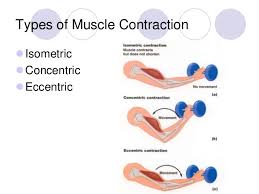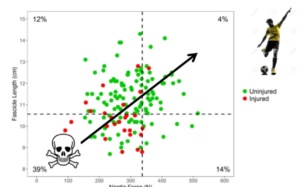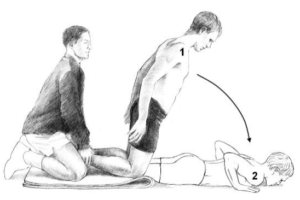Hamstring Strains – The latest Info to Get You Back to Training Fast
Let me first set the scene – it’s deep in the second half on a cool autumn afternoon with a crucial game of football up for grabs. You have worked hard over a long pre-season, but for some reason it doesn’t seem to have mattered – you are breathing heavily and your legs feel like lead. Suddenly the ball is quickly kicked out to the wing and it’s a foot race between you and your opponent to gain possession for  your team. The crowd and your teammates scream their support, which gives you a small burst of adrenaline to burst past the other player. The bouncing ball is finally within reach, and as you slow down… TWANG!!! You reactively reach back and grab the back of your thigh with that familiar sharp pain. Yep – “you’ve done your hammy”. Again.
your team. The crowd and your teammates scream their support, which gives you a small burst of adrenaline to burst past the other player. The bouncing ball is finally within reach, and as you slow down… TWANG!!! You reactively reach back and grab the back of your thigh with that familiar sharp pain. Yep – “you’ve done your hammy”. Again.
Hamstring strains have been the leading cause of lost time injury in the AFL consistently over the last twenty years, whilst also being very prevalent in the other football codes and sprinting-related sports. Anecdotally in my experience playing at football clubs and as a physio this is also true at the amateur level also. Given their frequent nature (which hasn’t really reduced too much over the past several years) and the high rate of recurrence, a large amount of research has been conducted here and overseas to try and gain a greater insight into the risk factors of hamstring injury to see if we can implement more specific rehabilitation programs to return players back to sport as safely and quickly as possible, and hopefully avoid the occurrence of hamstring strains altogether.

Most recent research has focused on the effect of eccentric strength (i.e. performing resistance training as the muscle lengthens) after a large study conducted in 2008 in Danish soccer reported a 59% decrease in hamstring strains (and 86% reduction in recurrence rate) for players who performed a 10-week strength program using the Nordic exercise:
Since then it has been demonstrated that regaining adequate strength post hamstring is important in reducing the risk of another hamstring injury. Another recent focus has been on fascicle length – how long the individual fibres of the hamstring muscle are.
I recently attended a hamstring injury symposium leading up to the Commonwealth Games 2018 to learn about the latest research regarding hamstring injury in order to apply that to our patients. Key take-home messages were:
- One of the hamstring muscles (Biceps Femoris – Long Head) is involved in the majority of sprinting related injuries
- Exercise selection has differing activation patterns of the different hamstring muscles (particularly hip dominant vs knee dominant)
- Having Longer fascicles (muscle fibre length) and being stronger eccentrically decreases the risk of hamstring injury:

- Contraction mode (concentric vs eccentric, or a leg curl vs nordic) has a large effect on fascicle length and strength.
- Once you have attained a relatively high fascicle length through training, it can be maintained with very low volumes (8 reps per week!). But, if you stop that exercise completely, fascicle length reduces very quickly (2 weeks of rest).
- We can safely introduce specific strengthening exercise post hamstrings earlier than first thought, and progress those in a ‘milestone’ dependent manner, rather than have certain time frames – leading to an earlier return to sport with reduced recurrence risk.
If you are unlucky enough to sustain an acute hamstring strain, we recommend following the ‘POLICE’ guidelines:
P – Protect the area – do not continue to play/train or run
OL – Optimal loading – a physiotherapist can help prescribe the right amount of exercise to optimise initial tissue healing
I – Ice – Apply ice to the area (make sure to cover with a thin towel to avoid skin irritation) with 2-3 cycles 20 mins on and off
C – Compression – can be via a bandage, tubigrip or compression garments (i.e. shorts, skins)
E – Elevation – try and elevate the leg when resting
We can then help your rehabilitation process by providing an individualised program, as well as assessing other factors that may be pertinent to your individual risk, including load management strategies, low-back/plevic movement patterns and nerve tension. As always you can book online or call the clinic on 5500 6470.
Additionally, I am always happy to assist local teams and coaches to help their players reduce hamstring injury risk. For any further information or to arrange a chat send me an email – sammclaren@mygcphysio.com.au
Sam McLaren
Physiotherapist

